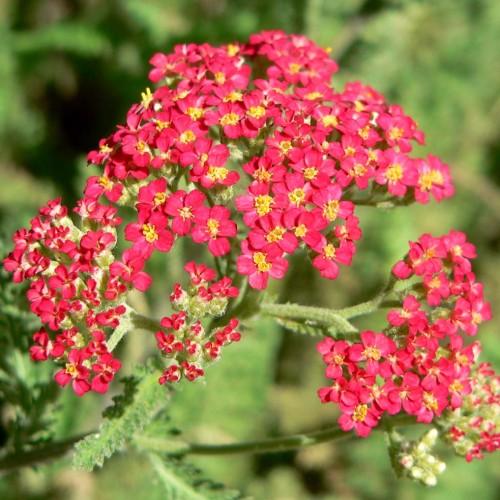
yarrow
Achillea millefolium 'Pomegranate'
Cycle:
Herbaceous Perennial
Watering:
Average
Hardiness Zone:
3 - 9
Flowers:
Flowers In Summer
Sun:
full sun
Soil:
Sandy Loamy Clay
Fruits:
Fruits In Summer Ready In Fall
Leaf:
Yes
Growth Rate:
Moderate
Maintenance:
Moderate
Drought Tolerant:
Yes
Salt Tolerant:
Yes
Care Level:
Medium
watering
Yarrow (Achillea millefolium 'Pomegranate') prefers consistently moist soil, so it should be watered as soon as the soil feels dry to the touch. Depending on its position and drainage, it may need to be watered as often as every other day during the hottest months. Avoid overwatering by allowing the top few inches of soil to dry before watering again. During the cooler months, water yarrow at least once or twice a week.
sunlight
Yarrow (Achillea millefolium 'Pomegranate) requires a minimum of 6 hours of direct sunlight each day, but can tolerate up to 8 hours of direct sunlight for optimal growth and flowering. The sunlight should be evenly distributed throughout the day for best results, and not all at once. Yarrow does not do well in full shade or partial shade, and the more sunlight it receives, the healthier it will be. The sunlight should be direct, and not filtered through a window, as this could hamper or even prevent flowering.
pruning
Pruning is essential for the health and growth of yarrow (Achillea millefolium 'Pomegranate'). Pruning should be done in early spring, before new growth appears. In general, the entire plant should be cut back a third of its total height in order to encourage fresh growth. The clumps can also be divided and replanted at this time. Deadheading or cutting off the spent flowers will also help keep the plant looking neat and promote reblooming.
Propagation
Season
Hardiness Map
FAQ
Do yarrow flowers come in different colors?
Yes, yarrow flowers come in a variety of colors, from white, yellow, pink, and red. Yarrow also comes in a unique bi-colored variety having yellow-orange flowers with a burgundy center. The different colors of yarrow lend a cheerful touch to your garden. Yarrow flowers are also said to bring good luck, so don't forget to add a few of these colorful blooms to your garden for some extra good vibes!
Is yarrow a hardy plant?
Yes, yarrow is a hardy plant. It typically grows in hard to cultivate areas and is relatively low maintenance, making it a great choice for novice gardeners. Yarrow is a hardy perennial, and in many cases will take hold in areas that other plants may not thrive in. It is known for its attractive, feathery leaves and can create a billowing, attractive addition to any garden border. Low water requirements make it ideal for those trying to reduce their water consumption.
Should yarrow be cut back after flowering?
Yes, yarrow should be cut back after flowering. This will help keep the plant healthy and encourage more blooms the following season. After the plant has finished flowering, it is important to prune off dead flowers and trim back the leaves that may have yellowed or died back during the growing season. Making sure to cut the plant back to about 6 inches above the ground allows it to have a neat and tidy appearance and helps promote bushy growth. Regularly deadheading the plant and cutting back at the end of the season will help keep your yarrow healthy and beautiful for years to come.
Do yarrow flowers attract pollinators?
Yes, yarrow flowers are a popular plant to attract pollinators. They have a sweet aroma that entices bees, butterflies, and other pollinators. The flower heads are also arranged in an open dome shape that makes them easier to access and explore by pollinators looking for nectar. Yarrow flowers also tend to bloom in late spring and summer, making them an integral part of a thriving pollinator habitat.
Do yarrow flowers bloom all summer?
No, yarrow flowers do not bloom all summer. Yarrow flowers typically bloom from late spring through midsummer, typically from late May or early June until mid to late July or early August. The exact bloom time will vary depending on climate and growing conditions as well as the variety of yarrow. After blooming, the plant will continue producing new foliage throughout the summer and into fall.
Is yarrow a perennial or annual plant?
Yarrow (Achillea millefolium) is a perennial plant, meaning it lives longer than two years and will come back each year. Yarrow is drought tolerant and grows in many soils and climates. This low-maintenance, hardy herb is often used in landscape or garden design and is a familiar wildflower in fields and along roadsides.
Are yarrow flowers suitable for drought-tolerant landscaping?
Yes, yarrow flowers are a very suitable option for drought-tolerant landscaping. These perennials are known for their ability to thrive in dry conditions and can add both height and color to a landscape. They are also known for their ability to attract beneficial insects such as bees, butterflies, and other pollinators, making them an excellent choice for eco-friendly gardens. Yarrow requires little to no maintenance, making them a perfect choice for busy or eco-conscious gardeners.
Should yarrow be deadheaded?
Yes, yarrow should be deadheaded to help keep the bloom period long and prevent the flower from going to seed. Deadheading is the process of removing faded or spent flowers from a plant so that new flowers can grow in its place. Yarrow flowers prefer deadheading in order to become showy, bushy and floriferous. It also prevents excess seeding which can create an unwanted forest of yarrow in the garden. If left unpruned, yarrow can become stretched and leggy. Pruning and deadheading yarrow can also help keep the plant looking its best.
